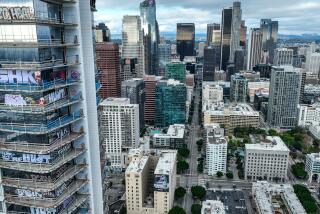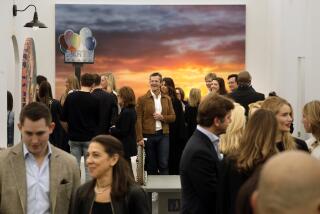Taking it to the streets, art that is
CINCINNATI — Giant frogs in Toledo, Ohio. Fiberglass horses in Lexington, Ky. Baseball bats in Cincinnati.
Public art displays that date to a 1998 fiberglass cow exhibit in Zurich, Switzerland, and Chicago’s follow-up “Cows on Parade” in 1999 have been big business for cities. Organizers say they bring art to the public and showcase local talent. But critics argue that the increasingly popular exhibits degrade art.
Tom Eccles, director of the Public Art Fund in New York City, said he would prefer cities support displays of contemporary art to expose the public to serious themes and fresh ideas.
“With the cows and the pigs and whatever comes next, I feel it’s sort of a circus performance that has been done to promote town centers,” said Eccles, whose organization sponsors art displays in Central Park and other New York sites. “On one level, they’re harmless fun. On another level, they’re kind of a dumbing-down of culture.”
Cincinnati was host to the “Big Pig Gig” in 2000, when about 400 decorated fiberglass pigs were exhibited in the city for nearly six months, harkening to Cincinnati’s past as an 1800s hog-slaughtering capital.
An economic study prepared for ArtWorks, the nonprofit producer of the Pig Gig, estimated that the display helped to generate $124 million in business sales, including spending by visitors.
Banking on the success of the Pig Gig, ArtWorks is sponsoring the Bats Incredible! project, on view through mid-October. About 140 artists and about 40 school groups were commissioned to produce sculptures with 34-inch ash baseball bats.
The theme recalls the city’s history as home of the nation’s first professional baseball team, the 1869 Cincinnati Red Stockings.
Such exhibits generally enlist artists for a fee, backed by sponsors that either keep the sculpture or donate it to be auctioned for charity.
“They’re a gamble. They typically don’t make money until the auction at the end,” ArtWorks spokeswoman Betsy Neyer said.
Michael Lash, director of public art for the city of Chicago, said such exhibits bring art to those who might not go to museums. Chicago’s exhibit was followed by street displays of furniture artwork titled “Suite Home Chicago” in 2001. The city is planning an “Art in the Garden” exhibit next year in which artists will design gardens.
“It desanctifies the whole idea of art in general,” Lash said. “All of a sudden, you’re in a relationship with an art object and nobody’s telling you how to behave. There’s no fee. Nobody’s telling you to speak in hushed tones.”
Chicago Commissioner of Cultural Affairs Lois Weisberg concedes the cows were not “great art.” “But they were out on the streets. People could see the colors,” she said.
The Lexington Arts and Cultural Council continues to sell copies of a book it published as a guide for its 2000 display of decorated horses on the streets of Lexington, long a center of the nation’s horse racing industry.
Council President Jim Clark said the exhibit generated $1.7 million, including $700,000 distributed to arts and cultural organizations and $370,000 for a trust fund to support public art. The horses were auctioned for an average price of $10,000 and one sold for $53,000, Clark said.
The council is now sponsoring “Dynamic Doors: Portals to Creativity,” a display of 128 decorated doors that were salvaged from the Bluegrass-Aspendale housing project built during the Depression and razed last year.
The displays seem to resonate with the public, especially if the themes are keyed to a city’s history, Clark said.
“As you can imagine, the horse touches a chord here ... the horse being central to our economy in Lexington,” he said. “It’s a great way of getting a lot of people and community groups involved in the arts and public art, in particular.”
Eccles said he believes the public would appreciate a higher level of artistic expression.
“I find the idea of cows and pigs decorated by artists kind of depressing,” Eccles said. “If that’s the best we can do with our artists today, we’re in a sad place.”
More to Read
The biggest entertainment stories
Get our big stories about Hollywood, film, television, music, arts, culture and more right in your inbox as soon as they publish.
You may occasionally receive promotional content from the Los Angeles Times.










